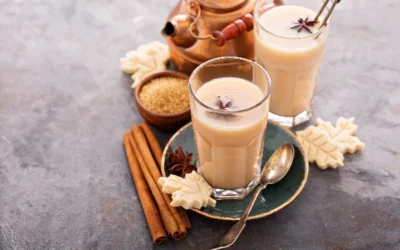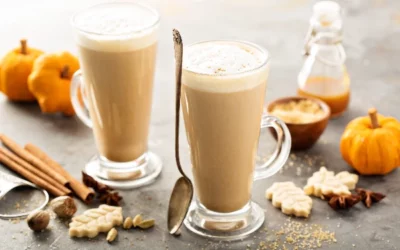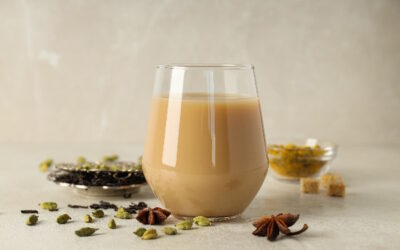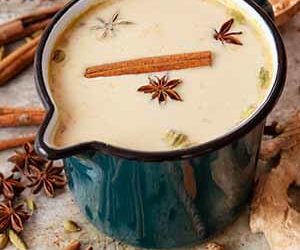Curious about whether a chai latte contains caffeine? You’re not alone. As a lover of both coffee and tea, understanding the caffeine levels in your favourite drinks is essential, especially if you’re mindful of your intake. In this article, I’ll guide you through the rich history and preparation of chai lattes, revealing their intriguing origins and flavourful spices. We’ll explore how their caffeine content stacks up against other popular beverages, and I’ll share tips on adapting your chai latte to suit your caffeine sensitivity or health goals. Whether you’re a caffeine enthusiast or just want to enjoy a warm, spiced drink without the jitters, there’s something for everyone. So let’s dive in and uncover everything you need to know about chai lattes!
Table of Content
- Does a chai latte contain caffeine?
- How much caffeine is in a chai latte compared to other beverages?
- What factors influence the caffeine content in a chai latte?
- Is a chai latte suitable for people sensitive to caffeine?
- How can you make a chai latte with decaf tea?
- What are the health benefits and drawbacks of drinking chai lattes?
- How does the caffeine content in chai lattes affect sleep?
- Conclusion
Does a chai latte contain caffeine?
Yes, a chai latte typically contains caffeine. This is because it is made with black tea, which naturally contains caffeine. The amount of caffeine in a chai latte can vary depending on the type and amount of tea used, as well as how it is prepared. On average, a standard chai latte from a coffee shop can contain between 40 to 70 milligrams of caffeine per serving.
The caffeine content is significant but generally lower than a regular cup of coffee. Understanding more about chai lattes, including their origin, ingredients, and various preparations, provides a fuller picture of this beloved drink.
Chai lattes, with their rich, aromatic blend of spices and creamy texture, have a fascinating backstory. Originating in India, “chai” simply means tea. The traditional drink, masala chai, is made by brewing black tea with a mixture of aromatic spices and herbs. Spices typically include cinnamon, cardamom, cloves, ginger, and peppercorn. Over time, this traditional preparation found its way into coffee shops worldwide and transformed into the chai latte, a spiced tea mixed with steamed milk, often sweetened.
What are the main ingredients of a chai latte?
The essence of a chai latte lies in its ingredients:
- Black tea: Provides the base and caffeine content.
- Spices: Includes cinnamon, cardamom, cloves, ginger, and peppercorn.
- Milk: Adds creaminess.
- Sweeteners: Often sugar, honey, or syrup are used.
These ingredients combined create its unique flavour. Traditional spices add depth and warmth, while the milk makes it smooth and comforting. Sweeteners enhance the aromatic spices.
How is a chai latte traditionally prepared?
You can make a chai latte using a straightforward process:
- Brew a strong concentrate of black tea with spices.
- Strain the mixture to remove the solid spices.
- Heat and froth milk separately.
- Combine the tea concentrate and frothed milk.
- Sweeten to taste.
This method keeps the spices’ flavour robust. The steps ensure a well-balanced drink, letting the spices and tea shine through the creamy milk.
What variations of chai lattes exist?
Chai lattes have inspired several delicious variations:
- Iced Chai Latte: Served cold, perfect for hot days.
- Dirty Chai Latte: Includes a shot of espresso for an extra caffeine kick.
- Vanilla Chai Latte: Adds vanilla syrup for additional sweetness.
- Vegan Chai Latte: Uses plant-based milk like almond or oat instead of dairy.
Each variation brings a unique twist. Adding espresso makes it richer, while plant-based milk caters to dietary preferences. The vanilla version offers a smooth, sweet alternative.
In the 19th century, the British East India Company started cultivating tea in India to break China’s monopoly on tea production. This catalyst introduced tea to the Indian masses. Over time, Indian tea vendors, known as “chaiwalas,” began adding local spices to create masala chai. This innovation made tea affordable and popular among all social classes. Today, the global fascination with chai lattes resonates with that blend of history and flavour.
I remember my first encounter with chai latte at a small café. Curious, I ordered it without knowing what to expect. The first sip exploded with warm, spicy flavours, complemented by the creaminess of steamed milk. The experience was like wrapping myself in a warm blanket on a cold day. Since then, chai lattes have become a go-to comfort drink, each cup reminding me of that first delightful taste.
How much caffeine is in a chai latte compared to other beverages?
Comparing the caffeine content in a chai latte to other drinks can give you a clearer picture of how it fits into your daily caffeine intake. Here’s a detailed comparison of the caffeine content in chai lattes and other popular beverages. This will help you make informed choices whether you’re cutting down or just curious about your caffeine consumption.
| Beverage Type | Average Caffeine Content per Serving | Factors Affecting Caffeine Content |
|---|---|---|
| Chai Latte | 40-60 mg | Type of black tea, brewing time |
| Black Coffee | 95 mg | Coffee bean type, brewing method |
| Espresso | 63 mg per shot | Bean grind size, pressure used |
| Green Tea | 20-45 mg | Tea variety, steeping time |
| Black Tea | 40-70 mg | Tea leaf quality, brewing duration |
| Matcha Tea | 70 mg | Leaf quality, preparation method |
| Decaf Coffee | 2-5 mg | Decaffeination process |
| Soft Drink (Cola) | 30-40 mg | Brand, formulation |
To understand the table:
- The Beverage Type column lists different drinks.
- The Average Caffeine Content per Serving column gives an average range or specific amount of caffeine in a typical serving size.
- The Factors Affecting Caffeine Content column identifies elements that can alter the caffeine levels within each beverage type.
So, when you choose a chai latte, you’re generally ingesting less caffeine than you would from a standard cup of black coffee.
Why is understanding caffeine content important?
Knowing the caffeine content can help you manage your intake better. This is especially true for those sensitive to caffeine or trying to cut back for health reasons. Here are some reasons why tracking your caffeine is critical:
- Sleep Quality: Excessive caffeine can interfere with your sleep cycle.
- Heart Health: High caffeine intake could increase heart rate or blood pressure in some individuals.
- Digestive Health: Some people may experience digestive discomfort from too much caffeine.
- Anxiety Levels: Caffeine can exacerbate anxiety symptoms.
- Bone Health: Excess caffeine might affect calcium absorption.
Balancing your caffeine intake from various sources can improve your overall health.
What should you consider when drinking a chai latte?
When you enjoy a chai latte, keep a few things in mind:
- Preparation Method: Homemade versions vs. store-bought can vary significantly in caffeine.
- Ingredients: Look out for additional caffeine sources in the mix.
- Quantity: Opt for regular sizes instead of large portions.
- Time of Day: Consider drinking it earlier to avoid sleep disturbance.
Having a mindful approach to how and when you consume your chai latte can enhance its benefits.
In the 1830s, the British East India Company introduced tea plantations in Assam. This initiative aimed to compete with China in the global tea market. Tea culture gradually permeated Indian society, not just influencing beverage choices but intertwining with the nation’s history and colonial struggles. The native chai blend evolved during this time, incorporating traditional Indian spices like cardamom, cinnamon, and cloves.
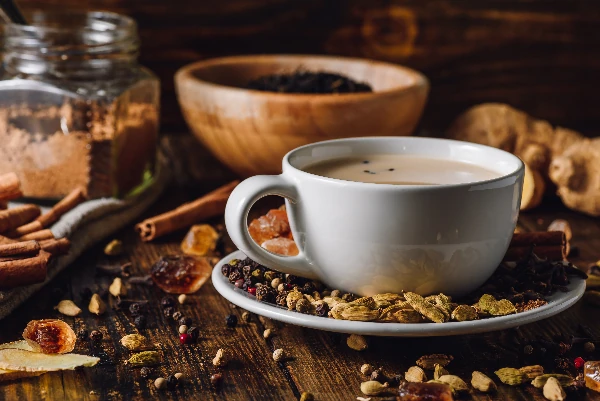
What factors influence the caffeine content in a chai latte?
Alright, so you’re sippin’ on a chai latte, basking in your blissful ignorance, not knowing the one burning question: How much caffeine is in this thing? You’re in luck because we’re about to peel back the layers of this spiced delight.
Several elements play a role in the caffeine roulette. We’re talking about the type of tea leaves used, how long the tea is brewed, the ratio of tea to milk, and even the preparation method. Last but not least, the serving size can also send your caffeine sensors into overdrive or let them remain in a zen state. Ready to navigate this maze?
How does the type of tea leaves affect caffeine content?
First up, let’s address the leaf elephant in the room. The kind of tea leaves used in your chai latte is like the foundation of a building – it’s crucial.
- Black tea leaves: These bad boys are usually the go-to for a traditional chai latte. Guess what? They bring the caffeine party.
- Green tea leaves: Not as common in chai, but when used, they have a slightly milder caffeine kick.
- Rooibos: This red “tea” is the caffeine-free darling. So, if you want zero caffeine, rooibos is your mate.
- Oolong tea leaves: These sit somewhere between black and green in terms of caffeine content and aren’t usually used in chai but hey, never say never.
So, whether it’s black tea revving your engine or rooibos driving you to snooze town, the choice of tea leaves sets the stage for your caffeine encounter.
What role does brewing time play in caffeine levels?
You’ve got your tea leaves picked out, now let’s talk brew time. Think of brewing as a balance between extracting flavour and unleashing caffeine.
- Short brew: Dip and go like you’re parched in the Sahara. You’ll get a lighter flavour and less caffeine.
- Medium brew: The Goldilocks zone for tea – extracting enough caffeine and flavour to keep you satisfied.
- Long brew: Leave it steeping long enough and you’ll wonder if it’s a chai latte or a chemistry experiment. Expect a caffeine surge and stronger flavours.
Your brewing choice can turn a mild tea into a jittery potion or a mellow, relaxing drink. It’s all in the timing, my friend.
How does the tea-to-milk ratio influence the caffeine content?
Tea-to-milk ratio might sound boring, but it’s the unsung hero in the caffeine saga.
- More tea, less milk: If you’re heavy on the tea and light on the milk, caffeine won’t be shy. It’s going to show up and be noticed.
- Equal parts tea and milk: A balanced act – you’re getting a fair share of both flavour and caffeine.
- More milk, less tea: More milk dilutes the caffeine content, and before you know it, you’re drinking spicy milk with a side of tea.
So, if you’re looking to tame the caffeine beast, add more milk. If you’re in it for the buzz, go light on the dairy.
Knowing how to juggle these factors is like being the maestro of your chai latte symphony. Now, clutch your cup of spiced goodness and enjoy the ride.
Speaking of caffeine and tea, did you know in the 1700s, the British went bananas for tea? But not just any tea – it was all about black tea, packed with that energising kick they so dearly loved. The British East India Company started shipping boatloads of it from China, turning the nation into a caffeine-addicted empire. London’s coffee houses morphed into tea salons and, voila, the humble tea leaf became a symbol of British culture. So next time you sip your chai latte, remember you’re participating in a tradition that’s spanned centuries and continents. Cheers to that!
Is a chai latte suitable for people sensitive to caffeine?
Let’s dive straight in, shall we? If you’re debating whether chai lattes cozy up nicely with your caffeine-sensitive self, you’ve come to the right place. First up, let’s address the elephant in the room: caffeine. Yes, your beloved chai latte does contain caffeine, but it’s not the same jolt you’d get from a triple-shot espresso. Whether this spicy, aromatic delight is friendly for those who get jittery from too much caffeine is another story.
Good old chai, a blend of black tea, milk, and spices like cinnamon, cardamom, and ginger, does sneak in some caffeine because of that black tea base. However, black tea isn’t a caffeine giant. It pales in comparison to coffee’s caffeine wallop. Assuming your caffeine tolerance is on a scale somewhere between “No Caffeine Zone” and “Coffee Chugger,” chai might still be on the table for you.
What are the signs of caffeine sensitivity?
Alright, let’s talk symptoms. Imagine your body’s red alert lights going off. They might look something like this:
- Jitters and Restlessness: You suddenly can’t stay still, and fidgeting becomes your new hobby.
- Rapid Heartbeat: Your heart decides to audition for a drum solo.
- Insomnia: Kissing sleep goodbye because your brain’s running a marathon.
- Headaches: The delightful throb that feels like someone’s playing the bongos on your skull.
- Digestive Issues: Unwanted trips to the restroom because your tummy’s not a happy camper.
- Anxiety: A sudden onset of feeling like the world’s closing in on you.
If you experience these fun perks after a caffeine fix, you might want to treat that chai latte with a bit of caution.
Are there decaffeinated chai latte options available?
Well, here’s some good news to turn that potential frown upside down. Decaf versions of chai do exist, because life’s too short to compromise on chai. When black tea doesn’t play nice with your system, opting for a decaf chai blend could be your saviour.
- Decaf Tea Bags: Same spicy goodness, minus the caffeine.
- Herbal Chai: Blends made with naturally caffeine-free herbs and spices.
- Loose Leaf Decaf: Fancy yourself a tea connoisseur? Loose leaf decaf is for you.
- Caffeine-Free Spices Only: Just the spices, no tea base – let’s call it chai essence.
- Commercial Decaf Mixes: Many brands offer decaf versions – just check those labels.
These options let you sip your chai without your body waving a white flag. A more gentle experience awaits you.
What are some low-caffeine alternatives to a chai latte?
Maybe decaf isn’t your vibe, but you still want that warm, spice-laden kiss of chai, minus the caffeine overload. Here are some low-caffeine alternatives that might just hit the spot:
- Rooibos Chai: Red bush tea from South Africa mixed with chai spices. Virtually caffeine-free.
- Green Tea Chai: Lower caffeine and still keeps the spirit of chai alive.
- Matcha Chai: Powdered green tea combining the gentle buzz of matcha and the zing of spices.
- White Tea Chai: Between green and black tea, gives a lighter caffeine dose with all that spicy goodness.
- Spice-Only Blends: Mix up some cinnamon, cloves, cardamom, and ginger. Add milk and enjoy – tea leaves not required.
Each alternative brings its own unique flair while dialing back that caffeine kick.
Speaking of chai’s roots, let’s hop back in time to the Mughal era in India. Emperor Shah Jahan, famous for the Taj Mahal, had a penchant for spicing up life – quite literally. It’s believed his court embraced spiced tea for its warming, digestive benefits. Over centuries, this spiced tea evolved into the chai we cherish today. So, next time you sip on that cup, think of it as enjoying a royal tradition!
So there you have it, caffeine-sensitive comrades. Whether it’s decaf, rooibos, or just a spice blend, chai’s got something for everyone. Cheers to sipping smart!
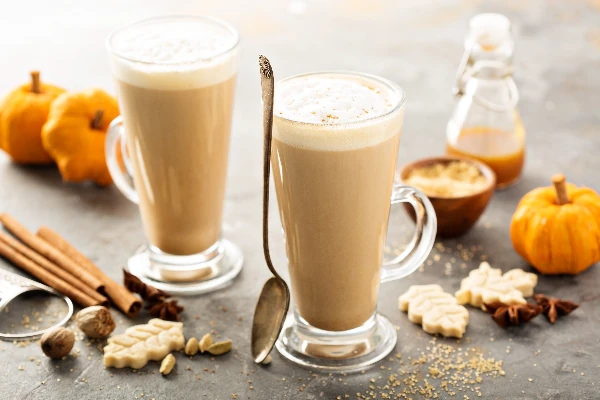
How can you make a chai latte with decaf tea?
Got an itch for a chai latte but worried about the caffeine keeping you up all night? You’re in luck because we’re about to dive into the world of decaf chai lattes—where you can have all the spicy, creamy deliciousness without the jitters.
What are the best decaf teas for making a chai latte?
Alright, let’s talk tea. Decaf tea doesn’t get as much love as its caffeinated cousin, but it’s a game-changer for chai latte lovers wanting to dodge caffeine. Here are some top decaf teas to jazz up your chai:
- Twinings Decaffeinated Chai Tea: Known for its balance of warming spices and bold flavour.
- Tazo Decaf Chai: Offers a robust flavour with hints of cardamom and black pepper.
- Numi Decaf Ginger Lemon: Not specifically for chai, but its ginger notes blend beautifully with chai spices.
- Celestial Seasonings Decaf India Spice Chai: This one’s got a rich and smooth profile that screams comfort.
- Stash Decaf Chai Spice: Known for a full-bodied taste and fragrant spices.
You get the drift. The idea is to pick a tea that’s already packed with spicy goodness so that your chai doesn’t feel like it’s diluted.
How do you prepare a chai latte with decaf tea?
So, you’ve got your decaf tea. Now what? Making a chai latte isn’t rocket science, but it does require a bit of finesse. Follow these steps, and you’ll be sipping on a decaf dream in no time:
- Boil water: Get your kettle whistling.
- Steep the decaf tea: Place a couple of decaf tea bags into the boiling water. Let them steep for around 5-7 minutes.
- Simmer with spices: Throw in your chai spices—think cinnamon sticks, cardamom pods, cloves, and star anise. Simmer for another 5 minutes.
- Prepare the milk: Heat up your choice of milk. Whole milk, almond milk, oat milk—you do you.
- Combine and sweeten: Mix the spicy tea and milk together. Add honey, sugar, or even a splash of vanilla extract for a bit of sweetness.
- Strain and serve: Use a fine mesh strainer to remove the spices as you pour the chai into your favourite mug.
And just like that, you’ve got yourself a chai latte that’s ready to impress.
How can you ensure the chai latte retains its flavour with decaf tea?
Decaf teas can sometimes be wimpy in the flavour department. But don’t worry—there are ways to keep your chai latte tasting as bold as a Herculean hero:
- Double up on the tea bags: Brew with two decaf tea bags instead of one.
- Extended steeping: Give it a longer steep time to squeeze out every bit of flavour.
- Boost the spices: Add extra ginger, cinnamon, and cardamom to make up for any lost intensity.
- Sweeten smartly: A tiny bit of molasses or maple syrup can add depth without being overpowering.
- Use high-quality spices: Fresh, vibrant spices make a world of difference.
By paying attention to these details, you’ll ensure your decaf chai latte punches well above its caffeine-free status.
Craving a chai that’s well-rounded and flavourful is perfectly normal. If you continue to infuse spices and adjust steeping times, you’ll hit the jackpot sooner rather than later.
Fun fact: Chai lattes have been around for centuries, but here’s a quirky story for those who love a good historical tidbit. During the British Raj in India, a major tea company called the British East India Company capitalised on Indian spices and tea. They didn’t quite hit on the chai latte, but they laid down the foundation. Decades later, the marriage of local spices with tea became the go-to for chai lovers across the globe. So, next time you sip your decaf chai latte, remember that it’s a drink steeped in history and global influences, minus the caffeine kick!
What are the health benefits and drawbacks of drinking chai lattes?
Alright, let’s talk about the good, the bad, and the delicious when it comes to chai lattes. These spicy, creamy concoctions are more than just a treat for your taste buds; they come with some notable health benefits and a few drawbacks you might want to know about.
What are the health benefits of the spices used in chai lattes?
The potent spices in chai lattes offer a smorgasbord of health perks. Here’s a breakdown of these powerhouse ingredients:
- Cinnamon: Known for its anti-inflammatory properties, it can help lower blood sugar levels.
- Ginger: Aids digestion, reduces nausea, and has anti-inflammatory effects.
- Cardamom: Enhances digestion and can help with fighting bad breath.
- Cloves: Packed with antioxidants and can support dental health.
- Black pepper: Boosts metabolism and improves digestive health.
So, sipping on a chai latte isn’t just about getting cosy; you’re also soaking up a range of health benefits from these spices.
Are there any health drawbacks to drinking chai lattes regularly?
But hey, it’s not all sunshine and rainbows in the land of chai lattes. There are a few drawbacks you should keep in mind:
- Sugar content: Those sweet chai lattes can pack a ton of sugar, which isn’t great for your waistline or your dentist’s mood.
- Calorie count: With added milk and sugar, they’re not exactly low-calorie.
- Potential allergens: Dairy, for instance, can be an issue if you’re lactose intolerant.
- Caffeine sensitivity: If you’re highly sensitive to caffeine, even the modest amount in a chai latte might bother you.
These factors might make you think twice before knocking back chai lattes like they’re water.
How can you make a healthier version of a chai latte?
Fear not, health-conscious friends! You can make a healthier chai latte at home with a few simple tweaks. Here’s how:
- Use unsweetened milk alternatives: Almond milk or coconut milk can cut down on calories.
- Natural sweeteners: Opt for honey or stevia instead of sugar.
- Control portion sizes: Make a smaller cup to keep calorie intake in check.
- Skip the whipped cream: It’s extra and not necessary.
- DIY spice mix: Create your own spice blend to control quality and quantity.
Making these adjustments lets you indulge in a chai latte minus the guilt or sugar crash.
Back in the day, Emperor Shah Jahan, the same guy who built the magnificent Taj Mahal, also had a thing for spiced tea. It’s said his royal kitchens crafted an early version of what we now know as chai. The drink was believed to aid digestion and boost overall health. So next time you sip on your chai latte, know that you’re partaking in a centuries-old tradition that was fit for a king!
How does the caffeine content in chai lattes affect sleep?
Alright, caffeine seekers and avoiders, get ready to dive into the caffeinated depths of chai lattes and their impact on your precious ZZZs. Let’s be honest, a chai latte is a delicious concoction, but that sneaky little thing does pack some caffeine – and that can mess with your snooze schedule if you’re not careful.
Caffeine is like the pick-me-up buddy that’s great during the day but overstays its welcome if you let it crash your evening party. When you indulge in a chai latte, that caffeine can play peek-a-boo with your sleep quality, making it tougher to fall asleep, stay asleep, or even get into those deep, restorative stages of sleep. Essentially, it turns your night into a tossing and turning bonanza.
How does caffeine affect sleep quality?
Caffeine has a knack for poking at your central nervous system, leaving you wide-eyed and bushy-tailed just when you should be drifting off peacefully. Here are some ways it can wreak havoc on your sleep:
- Delay in falling asleep: You might find yourself staring at the ceiling, counting sheep, but those caffeine-induced neurons are having a party.
- Decreased total sleep time: Less sleep means waking up groggier than a bear in winter.
- Reduced deep sleep: That crucial REM sleep phase gets shortchanged, leading to poor rest and recovery.
- Increased frequency of waking up: Light sleep stages dominate, causing disruptions throughout the night.
- Daytime sleepiness: The irony – the very thing meant to keep you awake messes up your night so bad, you need another caffeine fix the next day.
Caffeine’s just not a good bedtime buddy – it’s the noisy neighbour who refuses to let you get your beauty sleep.
When is the best time to drink a chai latte to avoid sleep disruption?
Now that we’ve established that caffeine and sleep are frenemies, let’s tackle the timing. You don’t have to say goodbye to chai lattes forever – just be smart about when you sip that magic potion.
- Early morning: Kick-start your day with a chai latte to help you shake off the slumber.
- Late morning: A mid-morning chai latte can be a delightful treat to keep you buzzing through lunch.
- Early afternoon: Enjoy it as a post-lunch pick-me-up to avoid the afternoon slump without jeopardising your sleep.
- Cut-off time: Aim to have your last chai latte 6-8 hours before bedtime to give caffeine enough time to exit your system.
- Observe and adjust: Every individual feels the effects differently. Pay attention to your body’s signals and tweak your chai latte timings accordingly.
Remember, timing is crucial if you want your bed to love you back and not feel like an insomnia battleground.
What are some caffeine-free alternatives for evening consumption?
If you want to avoid the whole caffeine-sleep dilemma while still enjoying a warm, comforting evening drink, you’re in luck. There are plenty of options to satisfy your taste buds without the caffeine drama:
- Herbal teas: Chamomile, peppermint, and rooibos teas are soothing options that can help you unwind.
- Golden milk: This turmeric-based drink is tasty and boasts anti-inflammatory properties.
- Decaf chai latte: All the flavours, none of the caffeine – win-win!
- Warm milk: A classic bedtime beverage that can help you drift off to sleep faster.
- Hot chocolate: Opt for a caffeine-free version to satisfy those chocolatey cravings.
Avoiding caffeine in the evening doesn’t mean you need to sacrifice flavour – these alternatives prove that.
Back in the 1800s, when afternoon tea became a staple in British culture, Anna, the Duchess of Bedford, famously complained of a “sinking feeling” in the afternoon. Her solution? Introducing afternoon tea, complete with light sandwiches, cakes, and – you guessed it – tea. She didn’t need much caffeine to get through the evening, showing that timing and a bit of creativity can ensure you savour your beverage without any sleepless nights. So take a leaf out of Anna’s book – enjoy your chai latte early, and save those caffeine-free treats for bedtime.
Conclusion
Reflecting on the intricate world of chai lattes, we’ve journeyed through their rich origins, varied preparations, and the nuances of caffeine content that intrigue both enthusiasts and the health-conscious alike. From understanding that the spices and tea types used contribute significantly to both flavour and caffeine levels, to comparing the caffeination of chai lattes with an array of other beverages, it’s clear that this beloved drink is more than just a comforting brew; it carries with it a tapestry of cultural and culinary significance.
The findings outlined in the article emphasise the importance of being mindful of caffeine intake, particularly for those who are sensitive to its effects. With the flexibility to create chai lattes using decaffeinated tea or opting for lower-caffeine alternatives, there are ample opportunities for everyone to enjoy this delightful blend, regardless of dietary preferences. The ranking of popular brands also provides practical insights, allowing consumers to make informed choices based on taste and caffeine levels.
Next time you indulge in a chai latte, I encourage you to pay attention to its caffeine content and how it aligns with your personal health goals. Could your love for this aromatic drink lead you to explore a variety of teas and spices that resonate with your palate and lifestyle? Remember, what you choose to drink tells your own unique story in the vast landscape of flavour and wellness.
As I delve into my next cup, I ask myself: How does this simple blend of tea and spices fit into my daily rhythm? May your chai experience deepen as you consider its many layers—both in taste and in personal reflection.


